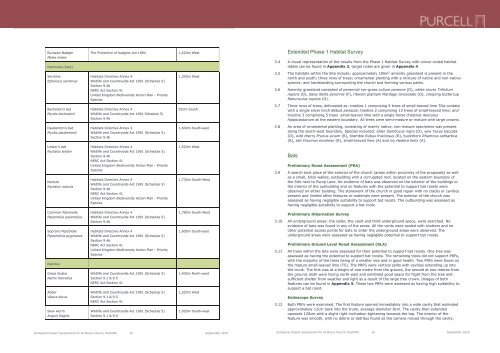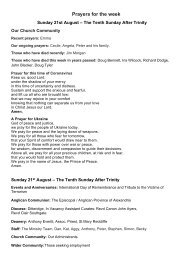St Mary Redcliffe Project 450 RIBA 2 Stage End Report
You also want an ePaper? Increase the reach of your titles
YUMPU automatically turns print PDFs into web optimized ePapers that Google loves.
Eurasian Badger<br />
Meles meles<br />
Mammals (bats)<br />
The Protection of badgers Act 1984<br />
1,620m West<br />
Extended Phase 1 Habitat Survey<br />
3.4 A visual representation of the results from the Phase 1 Habitat Survey with colour coded habitat<br />
labels can be found in Appendix 3, target notes are given in Appendix 4<br />
Serotine<br />
Eptesicus serotinus<br />
Habitats Directive Annex 4<br />
Wildlife and Countryside Act 1981 (Schedule 5)<br />
Section 9.4b<br />
NERC Act Section 41<br />
United Kingdom Biodiversity Action Plan - Priority<br />
Species<br />
1,200m West<br />
3.5 The habitats within the Site include: approximately 185m 2 amenity grassland is present in the<br />
north and south; three rows of trees; ornamental planting with a mixture of native and non-native<br />
species; and hardstanding surrounding the church and forming various paths.<br />
3.6 Amenity grassland consisted of perennial rye-grass Lolium perenne (D), white clover Trifolium<br />
repens (D), daisy Bellis perennis (F), ribwort plantain Plantago lanceolate (O), creeping buttercup<br />
Ranunculus repens (O).<br />
Bechstein’s bat<br />
Myotis bechsteinii<br />
Habitats Directive Annex 4<br />
Wildlife and Countryside Act 1981 Schedule 5)<br />
Section 9.4b<br />
910m South<br />
3.7 Three rows of trees, delineated as: treeline 1 comprising 9 trees of small-leaved lime Tilia cordata<br />
with a single silver birch Betula pendula; treeline 2 comprising 13 trees of small-leaved lime; and<br />
treeline 3 comprising 5 trees small-leaved lime with a single horse chestnut Aesculus<br />
hippocastanum at the eastern boundary. All trees were semi-mature or mature with large crowns.<br />
Daubenton’s bat<br />
Myotis daubentonii<br />
Habitats Directive Annex 4<br />
Wildlife and Countryside Act 1981 (Schedule 5)<br />
Section 9.4b<br />
1,600m South-east<br />
3.8 An area of ornamental planting, consisting of mainly native, non-mature specimens was present<br />
along the south-west boundary. Species included: elder Sambucus nigra (O), yew Taxus baccata<br />
(O), wild cherry Prunus avium (R), bramble Rubus fruticosus (R), buckthorn Rhamnus cathartica<br />
(R), ash Fraxinus excelsior (R), small-leaved lime (A) and ivy Hedera helix (A).<br />
Leisler’s bat<br />
Nyctalus leisleri<br />
Noctule<br />
Nyctalus noctula<br />
Habitats Directive Annex 4<br />
Wildlife and Countryside Act 1981 (Schedule 5)<br />
Section 9.4b<br />
NERC Act Section 41<br />
United Kingdom Biodiversity Action Plan - Priority<br />
Species<br />
Habitats Directive Annex 4<br />
Wildlife and Countryside Act 1981 (Schedule 5)<br />
Section 9.4b<br />
NERC Act Section 41<br />
United Kingdom Biodiversity Action Plan - Priority<br />
Species<br />
1,520m West<br />
1,730m South-West<br />
Bats<br />
Preliminary Roost Assessment (PRA)<br />
3.9 A search took place of the exterior of the church (areas within proximity of the proposals) as well<br />
as a small, brick walled, outbuilding with a corrugated roof, located on the eastern boundary of<br />
the Site next to Pump Lane. No evidence of bats was observed on the exterior of the buildings or<br />
the interior of the outbuilding and no features with the potential to support bat roosts were<br />
observed on either building. The stonework of the church in good repair with no cracks or cavities<br />
present and limited other features or materials were present. The exterior of the church was<br />
assessed as having negligible suitability to support bat roosts. The outbuilding was assessed as<br />
having negligible suitability to support a bat roost.<br />
Common Pipistrelle<br />
Pipistrellus pipistrellus<br />
Soprano Pipistrelle<br />
Pipestrellus pygmaeus<br />
Reptiles<br />
Grass Snake<br />
Natrix Helvetica<br />
Adder<br />
Vipera berus<br />
Slow worm<br />
Anguis fragilis<br />
Habitats Directive Annex 4<br />
Wildlife and Countryside Act 1981 (Schedule 5)<br />
Section 9.4b<br />
Habitats Directive Annex 4<br />
Wildlife and Countryside Act 1981 (Schedule 5)<br />
Section 9.4b<br />
NERC Act Section 41<br />
United Kingdom Biodiversity Action Plan - Priority<br />
Species<br />
Wildlife and Countryside Act 1981 (Schedule 5)<br />
Section 9.1 & 9.5<br />
NERC Act Section 41<br />
Wildlife and Countryside Act 1981 (Schedule 5)<br />
Section 9.1 & 9.5<br />
NERC Act Section 41<br />
Wildlife and Countryside Act 1981 (Schedule 5)<br />
Section 9.1 & 9.5<br />
1,780m South-West<br />
1,600m South-east<br />
1,400m North-west<br />
1,520m West<br />
1,020m South-west<br />
Preliminary Hibernation Survey<br />
3.10 All underground areas: the cellar, the vault and third underground space, were searched. No<br />
evidence of bats was found in any of the areas. All the vents were sealed with shutters and no<br />
other potential access points for bats to enter the underground areas were observed. The<br />
underground areas were assessed as having negligible potential to support bat roosts.<br />
Preliminary Ground Level Roost Assessment (GLA)<br />
3.11 All trees within the Site were assessed for their potential to support bat roosts. One tree was<br />
assessed as having the potential to support bat roosts. The remaining trees did not support PRFs,<br />
with the majority of the trees being of a smaller size and in good health. Two PRFs were found on<br />
the mature small-leaved lime (T5). The PRFS were vertical splits with cavities extending up into<br />
the trunk. The first was at a height of one metre from the ground, the second at two metres from<br />
the ground. Both were facing north-east and exhibited good space for flight from the tree and<br />
sufficient shelter from weather and light as a result of the large tree crown. Images of both<br />
features can be found in Appendix 5. These two PRFs were assessed as having high suitability to<br />
support a bat roost.<br />
<strong>End</strong>oscope Survey<br />
3.12 Both PRFs were examined. The first feature opened immediately into a wide cavity that extended<br />
approximately 12cm back into the trunk, average diameter 8cm. The cavity then extended<br />
upwards 120cm with a slight right inclination tightening towards the top. The interior of the<br />
feature was smooth, with no debris or detritus found as the camera moved through the cavity.<br />
Ecological Impact Assessment for <strong>St</strong>.<strong>Mary</strong>s Church, <strong>Redcliffe</strong> 15 September 2019<br />
Ecological Impact Assessment for <strong>St</strong>.<strong>Mary</strong>s Church, <strong>Redcliffe</strong> 16 September 2019


















